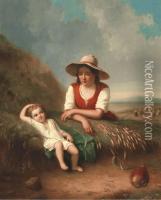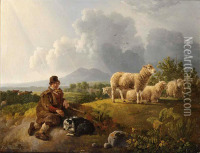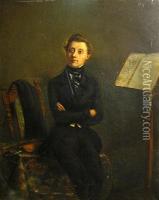Leendert, De Koningh Jnr. Paintings
Leendert de Koningh Jnr., born in 1777 in the Netherlands, was an artist whose work and life journey encapsulate the essence of Dutch Romantic painting during the late 18th and early 19th centuries. Though not as widely recognized as some of his contemporaries, De Koningh's contributions to the Dutch art scene were notable for their detailed landscapes and seascapes, which often depicted the tranquil and majestic beauty of the Dutch countryside and its waterways. His works are characterized by a meticulous attention to detail and a profound appreciation for natural light, aspects that have endeared his paintings to art enthusiasts and collectors alike.
De Koningh's artistic journey began in his early years, influenced by the rich artistic heritage of the Netherlands, a country renowned for its contributions to the Golden Age of painting. Despite the lack of comprehensive records about his early training, it is believed that he was deeply influenced by the works of earlier Dutch masters, which is evident in his meticulous approach to landscape painting. Throughout his career, De Koningh developed a style that was both reflective of the Romantic movement's emphasis on emotion and the sublime in nature, and deeply rooted in the Dutch painting tradition.
Throughout his life, De Koningh remained relatively secluded from the major artistic hubs of Europe, choosing instead to focus on capturing the essence of the Dutch landscape. His dedication to his craft resulted in a body of work that, while not vast, is highly regarded for its quality and the unique perspective it offers on the Dutch Romantic movement. De Koningh's paintings often feature serene waterscapes, bustling port scenes, and detailed rural landscapes, each infused with a sense of calm and a deep reverence for nature.
Leendert de Koningh Jnr. passed away in 1849, leaving behind a legacy that, though not as celebrated as that of some of his peers, offers invaluable insights into the Dutch Romantic period. His works continue to be appreciated by art historians and collectors for their beauty and historical value, serving as a testament to De Koningh's skill and his love for the Dutch landscape. Today, his paintings can be found in private collections and museums, where they continue to be studied and admired for their contribution to the Dutch Romantic tradition.





